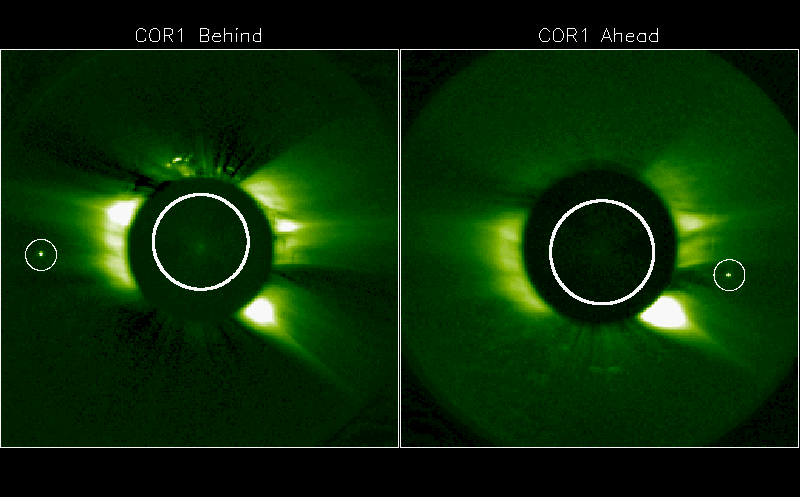|
Important notice about STEREO Behind
Planet identification in STEREO coronagraph images


 View Movie View Movie
We've been getting a lot of questions lately asking what this small round object was that passed through the COR2-Ahead field of view from December 22nd to January 2nd. Hence, we decided to post this to answer everybody's questions. It's the planet Mercury.
The easy way to identify it as Mercury is to use the STEREO Orbit Tool (http://stereo-ssc.nascom.nasa.gov/where/). Put in the date, e.g. 31 December 2007, and select the "Inner solar system" option. You'll see that Mercury and STEREO Ahead were directly opposite each other during that time period. This means that Mercury was passing behind the Sun as seen by STEREO Ahead. The motion would be from right to left, which is exactly what was seen. In fact, the direction of the motion by itself is enough to tell us that the object has to be within the inner solar system. Outer system planets like Jupiter always move from left to right.
(http://stereo.gsfc.nasa.gov/gallery/preview/stereoimages_jupiter.shtml)
This is not the first time that Mercury has been seen in the STEREO coronagraph images. Back in May 2007, the STEREO COR1 telescopes captured these simultaneous images of Mercury from both spacecraft (attached image). The COR1 team was able to use these images to calculate the three-dimensional position of Mercury within the solar system, and compare it against the predicted position. This successful test was used to validate the COR1 pointing calibration.
The STEREO coronagraphs are designed to look at the faint solar corona. Planets, on the other hand, are very bright and tend to saturate in the detectors. Because of this, they generally end up looking much larger than they really are, and are often surrounded by lens flare effects. This is particularly true for COR2, which is much more sensitive than COR1. In the even more sensitive Heliospheric Imager telescopes, the planets images tend to bleed along the CCD channels, forming vertical streaks. (http://stereo.gsfc.nasa.gov/gallery/preview/stereoimages_hi1hi2ab_sky.shtml).
Last Revised: Tuesday, 15-Jan-2008 10:24:43 EST
Responsible NASA Official: ![[email address: therese.a.kucera<at>nasa<dot>gov]](/img/kucera_email.jpg)
Privacy Policy and Important Notices
Accessibility
Webmaster: Apexa Patel
|